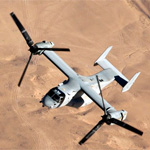First intercontinental MV-22 Osprey flight

The Marine Corps completed an aviation first, April 8, by flying MV-22B Ospreys on the aircraft’s longest movement to date. Six Ospreys with Marine Medium Tiltrotor Squadron 266 returned to the 26th Marine Expeditionary Unit after a trek from Camp Bastion, Afghanistan, to Souda Bay, Greece, with the assistance of a pair of KC-130J Hercules from 2nd Marine Aircraft Wing (Forward) who provided transport and aerial refueling support.
“As far as aerial refueling missions are concerned, this was a Marine Corps and Naval aviation first,” said Capt. Ben Grant, the executive officer for the Marine Aerial Refueler Transport Squadron 252 detachment currently deployed in support of operations in Afghanistan. “Never before has an MV-22 movement been conducted this far or on this scale. On this mission, the MV-22s travelled in excess of over 2,800 miles from Camp Bastion to Souda Bay, using aerial refueling provided by KC-130Js. We transited three continents over land and water, three combatant commands’ areas of responsibility, and did it with no major issues.”
The mission was conducted to return VMM-266 Marines, cargo and aircraft to the USS Kearsarge and the 26th MEU, which had been tasked to the Mediterranean region in support of operations in Libya.
“This mission validated a capability that should ultimately be seen as routine,” said Grant. “We affirmed the ability of the MV-22 to be long-range deployed with KC-130J support.”
Grant said the mission was conducted over two separate movements consisting of two Hercules and three Ospreys. During both movements, the KC-130Js not only refueled the MV-22Bs, but also transported more than 50,000 pounds of VMM-266’s essential cargo, maintenance and support equipment. Nearly 100 Marines also made the journey, so they could join the rest of the 26th MEU and prepare for their return to the U.S.
“Our weather radar, familiarity with international flying, cargo capacity, communications and navigational abilities, and ability to aerial refuel the MV-22 makes us a combat multiplier for them, ensuring their success,” Grant said of the KC-130J’s abilities. Grant said the mission went well, a result of not only planning, but the Marines’ ability to adapt to the situation.
“Though we had prepared for a myriad of contingencies, none arose that required us to alter our timelines or routing,” said Grant. “While each movement encountered expected and unexpected friction that had to be immediately addressed, each was handled superbly by the KC-130J and MV-22 Marines. Everyone involved worked as a team of professionals.”
Grant said while the mission was the first of its type at this scale, he believes more missions of this nature will occur in the future. He said he sees movement like this becoming as routine for the Osprey as they are for other Marine Corps aircraft including F/A-18 Hornets, AV-8B Harriers and CH-53E Super Stallions.
“It was not without many learning points for both the MV-22 and KC-130J crews,” said Grant. “We are still developing and refining these procedures as the MV-22 continues to mature. Great credit goes to the MV-22 pilots and crews for their ‘can-do’ attitude and planning of these two movements.”
Since responding to a request to support Regional Command Southwest’s area of operations, the “Fighting Griffins” of VMM-266, based out of Marine Corps Air Station New River, N.C., have provided aviation and assault support for 3rd Battalion, 8th Marine Regiment and other coalition ground forces in Afghanistan, explained Lt. Col. Romin Dasmalchi, the VMM-266 commanding officer. Simultaneously, other elements of VMM-266, including reinforcements from an AV-8B Harrier detachment, participated in other activities, notably recent operations in Libya.
“It’s been a challenging deployment for the Marines here,” Dasmalchi said. “They’ve been split up into two theaters and have found motivation in the fact that the squadron was still able to operate with great success.”
Before VMM-266 departed Afghanistan, the squadron and VMM-264, another New River, N.C.-based MV-22B squadron, conducted an aircraft exchange allowing four of VMM-264’s Ospreys to return back to the U.S. for maintenance. In return VMM-264 inherited four newer Ospreys from VMM-266 to continue to conduct operations in Afghanistan, said Dasmalchi.
“Our Marines had their work cut out for them once we accepted these older aircraft,” said Dasmalchi. “The aircraft had to be operationally sound before we embarked on the long-range flight to Souda Bay. The Marines did an incredible job, logging thousands of maintenance hours, all while supporting Regional Command Southwest simultaneously.”
Grant credited the mission’s success to KC-130J and MV-22 maintenance and support Marines, cooperation from the United Kingdom’s Royal Air Force, which aided with ramp space and air traffic control and support from other Marine units, like meteorological service. He also said many Marines throughout the region, other military services, and U.S. government agencies worked behind the scenes to ensure smooth coordination.
“As Marines, we are not just warriors from the sea. We are warriors, from anywhere to anywhere on the globe,” said Grant who also serves as a KC-130J weapons and tactics instructor. “This mission got the MV-22s on their way home. The next mission may be to get them to the fight, or from one fight to another.”